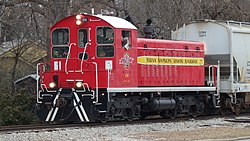Tulsa-Sapulpa Union Railway
 Tulsa-Sapulpa Union Railway's EMD SW1200 diesel locomotive #108 in 2020 | |
| Overview | |
|---|---|
| Headquarters | Sapulpa, Oklahoma |
| Reporting mark | TSU |
| Locale | Oklahoma; United States |
| Dates of operation | 1907–present |
| Technical | |
| Track gauge | 4 ft 8+1⁄2 in (1,435 mm) standard gauge |
| Length | 22.9 miles (36.9 km) |
Tulsa-Sapulpa Union Railway Company, L.L.C. (reporting mark TSU) is a Class III shortline rail carrier[1] which operates freight service between Tulsa, Oklahoma and Sapulpa, Oklahoma over 10 miles of track known as the Sapulpa Lead, and which also leases and operates a 12.9 mile section of Union Pacific track known as the Jenks Industrial Lead between Tulsa and Jenks, Oklahoma.[2][3] The line connects with two Class I railroads, being the Union Pacific at Tulsa and the BNSF at Sapulpa,[2] and additionally connects to its fellow Class III shortline, the Sand Springs Railway, in Tulsa.[4] It is owned by the Collins Family Trust.[5] Major customers on the Sapulpa Lead include Technotherm, Prescor, and Ardagh Glass,[5] and on the Jenks Industrial Lead, the HF Sinclair oil refinery, Kentube, Word Industries, Pepsi Cola, and Kimberly-Clark.[6]
History[edit]
The company started in 1907 as the Sapulpa & Interurban Railway, running electric trolley cars to carry workers between Sapulpa and various plants along the Arkansas River.[5][7] In 1908 it opened a route connecting Sapulpa to the towns of Kiefer, Glenpool, and Mounds in Oklahoma, to transport oil field workers to the Glenn Pool and Sapulpa-area oil fields.[2] Running through sparsely-populated areas and carrying little freight, the line was bankrupt by 1912, but merged with another interurban line, the Oklahoma Union Railway, in an attempt to help both.[7] Oklahoma Union served Tulsa and communities to the southwest, and had unsuccessfully tried to reach Sapulpa.[7] After a second bankruptcy in 1917, the combined company was again reorganized as the Sapulpa Electric Interurban Railway, and in 1918 completed the connection between Sapulpa and Tulsa, giving it a total route of 25 miles of track.[7] The Sapulpa-Mounds line was abandoned in 1928, and the company went bankrupt again in 1929.[2] In 1933, passenger service ended in favor of freight, and by 1934 or 1935 George Collins bought the line to service his glass plant in Sapulpa.[7][5] His line was incorporated as the Sapulpa Union Railway, with the name later changing to the Tulsa-Sapulpa Union Railway around 1943.[2][7]
Freight trains were operated by two electric boxcabs until 1955. The railroad purchased two Baldwin-Westinghouse electric locomotives from the Sand Springs Railway as replacements when that company ended electric operations that year. Electric freight trains continued on the Tulsa-Sapulpa Union Railway until 1960, when the wires were taken down and diesel locomotives took over, including a Davenport Locomotive Works switcher and two EMD SW1s.[8] A third SW1 was purchased later, followed by an EMD SW7 and an EMD SW9. These were joined by an EMD SW1200 by 2001.[8]
Operations[edit]
About 60% of rail traffic is inbound to customers on the line, while 40% of rail traffic is outbound.[3]
The railway operates 5 days a week, through two locomotives with one shift each,[3] utilizing five employees.[5] Its offices are in Sapulpa, where a preserved interurban trolley, the Maggie M, is on display.[9]
The current lease agreement with Union Pacific on the Jenks Industrial Lead was signed December 21, 2018 for an initial five-year term, which may be extended by TSU for an additional 15 years.[1]
References[edit]
- ^ a b "Tulsa-Sapulpa Union Railway Company, L.L.C.-Lease Renewal Exemption With Interchange Commitment-Union Pacific Railroad Company". The Federal Register (accessed on v\lex). Retrieved June 18, 2021.
- ^ a b c d e "Tulsa-Sapulpa Union Railway Company TSU #709". Union Pacific. Retrieved June 18, 2021.
- ^ a b c "Transportation". City of Sapulpa. Retrieved June 18, 2021.
- ^ "Sand Springs Railway". American-Rails.com. Retrieved June 18, 2021.
- ^ a b c d e "Short line railroads keep chugging along". Mike Coppock, Tulsa World, March 18, 2018. 18 March 2018. Retrieved June 18, 2021.
- ^ "Sapulpa Interurban Trolley". Sapulpa Historical Society & Museum. Retrieved June 18, 2021.
- ^ a b c d e f "Tulsa-Sapulpa Union Railway". American-Rails.com. Retrieved June 18, 2021.
- ^ a b Miller, Hal (April 2001). "Tulsa's Best". Trains. pp. 66–73 – via Ebscohost.
- ^ "Sapulpa Trolly Sapulpa Oklahoma". Greg Disch Photography. Retrieved June 18, 2021.
